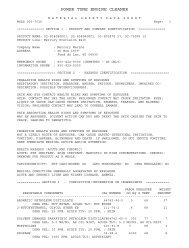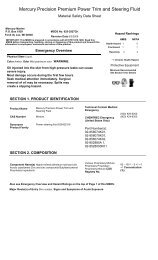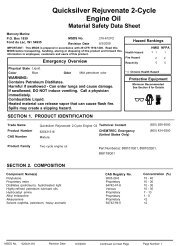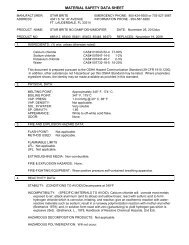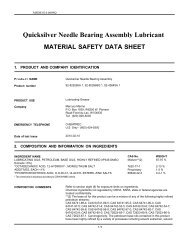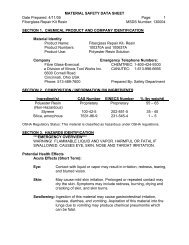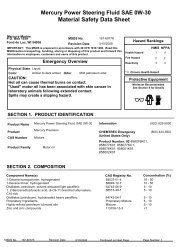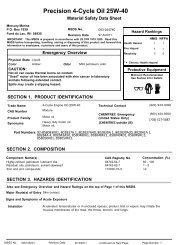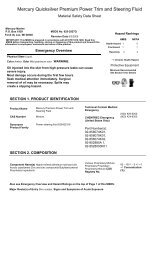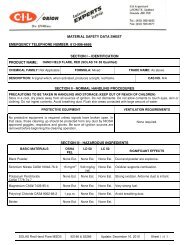Get the MSDS sheet - Midwest Corrosion Products
Get the MSDS sheet - Midwest Corrosion Products
Get the MSDS sheet - Midwest Corrosion Products
Create successful ePaper yourself
Turn your PDF publications into a flip-book with our unique Google optimized e-Paper software.
MATERIAL SAFETY DATA SHEET - PAGE 2 - <strong>Corrosion</strong> Block Bulk Liquid<br />
SECTION VII - TOXICOLOGICAL PROPERTIES<br />
<strong>Corrosion</strong> Block Bulk Liquid has been tested (oral, eye, dermal) as a complete mixture and is considered “Non-Toxic”<br />
according to EPA /OCED and FHSA guidelines.<br />
Primary Routes of entry:<br />
Acute Oral: LD50 > 5000 mg/kg Acute Eye: LC50 > 5000 mg/kg<br />
Acute Dermal: LD50 > 5000 mg/kg Acute Vapor LC50 > 5000 ppm -Rat-Aliphatic hydrocarbon<br />
(est.)<br />
LC50 > 5000 ppm -Rat-Petroleum distillate<br />
Carcinogenicity: Non-carcinogenic, according to NTP, IARC, OSHA or ACGIH.<br />
Sensitization:<br />
Non-sensitizer<br />
Mutagenic effects: No Tetragenic: No<br />
Reproductive: No Developmental: No<br />
EFFECTS OF OVEREXPOSURE:<br />
Inhalation:<br />
May cause headache, nausea, or dizziness.<br />
Skin and Eyes: May cause drying or chapping of skin. May cause redness of eyes<br />
Ingestion:<br />
May be harmful or fatal if swallowed.<br />
SECTION VIII - EMERGENCY AND FIRST AID PROCEDURES<br />
Skin: Remove excess by wiping, followed by washing with soap and water.<br />
Eyes: Copious warm water flush for 15 minutes, Physician assessment if eyes inflamed.<br />
Inhalation: Evacuate to fresh air. Apply CPR if required. If resuscitation was required <strong>the</strong>n a physician’s assessment is<br />
mandatory.<br />
Ingestion: DO NOT INDUCE VOMITING. Give 1/2 pint milk to drink. If vomiting takes place naturally, lean victim<br />
forward to prevent aspiration into lungs. Aspiration into <strong>the</strong> lungs may cause chemical pneumontis, which can be<br />
fatal. Mandatory physician assessment.. Note to Physician:Consult standard literature for Hydrocarbon poison.<br />
SECTION IX - PREVENTIVE MEASURES<br />
Steps to be taken if Spilled: Eliminate sources of ignition - Stop or reduce flow with barricades - Absorb small spills using<br />
dry clay, commercial sorbents. Collect residue into suitable container for disposal. Material may<br />
be drained into floor drains equipped with Oil Interceptors.<br />
Waste Disposal Method: Dispose in approved landfill site or incinerate at licensed waste reclaim facility. Liquid waste to<br />
be removed by licensed reclaimer, under Used Oil Classification. Follow all Local, Provincial,<br />
State and Federal Requirements. Liquid not listed as hazardous waste under RCRA.<br />
Ventilation:<br />
Provide sufficient General or Mechanical ventilation to maintain exposure below flammable<br />
limits.<br />
Respiratory Protection: None normally needed - Unless atomizing in enclosed space, <strong>the</strong>n use approved NIOSH organic<br />
mist/vapor, respirator.<br />
Protective Gloves:<br />
None normally needed.<br />
Eye Protection: None normally required, unless operator is using high-pressure spray equipment or splashing is<br />
likely.<br />
O<strong>the</strong>r Protective Clothing: None normally needed.<br />
Work/Hygienic Practices: Wash hands and face with soap and water after use. Launder soiled clothing.<br />
SECTION X - REGULATORY INFORMATION<br />
U.S. Federal Regulations: Not Regulated Zinc Compounds<br />
TSCA Inventory. All components included Reported/Included<br />
SARA Extreme Hazard: NO NO<br />
CERCLA: NO NO<br />
SARA Toxic Chemical: NO YES<br />
TITLE III Hazard Classification Section 311, 312: Section 313:<br />
Fire: No Chronic: No Pressure: No CAS# Name %-Wt.<br />
Reactivity: No Acute: No Not applicable Zinc Compound < 2



